Blog & Latest Updates
Fly Fishing Articles
Insects by Common Name


> > Miscellaneous
Closeup insects from Miscellaneous
Maccaffertium modestum (Cream Cahill) Mayfly Nymph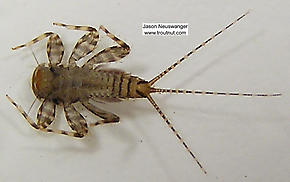 View 3 Pictures
View 3 Pictures
 View 3 Pictures
View 3 PicturesCollected March 10, 2004 from unknown in Wisconsin
Added to Troutnut.com by Troutnut on January 19, 2006
Added to Troutnut.com by Troutnut on January 19, 2006
Ephemera simulans (Brown Drake) Mayfly Nymph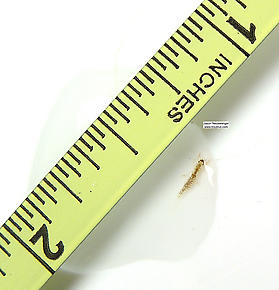 View 2 PicturesHere's an unusually small early instar (Instar: Many invertebrates molt through dozens of progressively larger and better-developed stages as they grow. Each of these stages is known as an instar. Hard-bodied nymphs typically molt through more instars than soft-bodied larvae.) nymph.
View 2 PicturesHere's an unusually small early instar (Instar: Many invertebrates molt through dozens of progressively larger and better-developed stages as they grow. Each of these stages is known as an instar. Hard-bodied nymphs typically molt through more instars than soft-bodied larvae.) nymph.
 View 2 PicturesHere's an unusually small early instar (Instar: Many invertebrates molt through dozens of progressively larger and better-developed stages as they grow. Each of these stages is known as an instar. Hard-bodied nymphs typically molt through more instars than soft-bodied larvae.) nymph.
View 2 PicturesHere's an unusually small early instar (Instar: Many invertebrates molt through dozens of progressively larger and better-developed stages as they grow. Each of these stages is known as an instar. Hard-bodied nymphs typically molt through more instars than soft-bodied larvae.) nymph.Collected March 1, 2004 from unknown in Wisconsin
Added to Troutnut.com by Troutnut on January 25, 2006
Added to Troutnut.com by Troutnut on January 25, 2006
Female Heptageniidae (March Browns, Cahills, Quill Gordons) Mayfly Spinner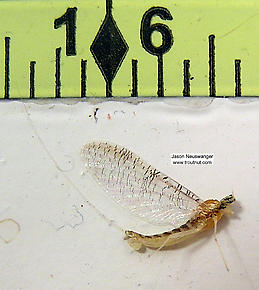 View 2 Pictures
View 2 Pictures
 View 2 Pictures
View 2 PicturesCollected July 27, 2004 from unknown in Wisconsin
Added to Troutnut.com by Troutnut on January 25, 2006
Added to Troutnut.com by Troutnut on January 25, 2006
Baetidae (Blue-Winged Olives) Mayfly Nymph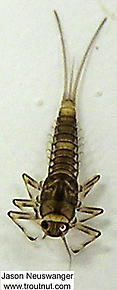 View 3 PicturesThis relatively large early March Baetid nymph has untracheated gills and no bands on its tails.
View 3 PicturesThis relatively large early March Baetid nymph has untracheated gills and no bands on its tails.
 View 3 PicturesThis relatively large early March Baetid nymph has untracheated gills and no bands on its tails.
View 3 PicturesThis relatively large early March Baetid nymph has untracheated gills and no bands on its tails.Collected March 9, 2004 from unknown in Wisconsin
Added to Troutnut.com by Troutnut on January 25, 2006
Added to Troutnut.com by Troutnut on January 25, 2006
Baetisca (Armored Mayflies) Mayfly Nymph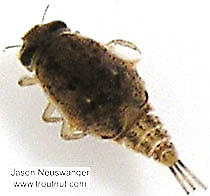 View 4 PicturesI'm unsure which species this is: it lacks the usual features of B. laurentina, but it's small, so maybe it's just an underdeveloped early instar (Instar: Many invertebrates molt through dozens of progressively larger and better-developed stages as they grow. Each of these stages is known as an instar. Hard-bodied nymphs typically molt through more instars than soft-bodied larvae.). Otherwise, it looks like it might be B. obesa.
View 4 PicturesI'm unsure which species this is: it lacks the usual features of B. laurentina, but it's small, so maybe it's just an underdeveloped early instar (Instar: Many invertebrates molt through dozens of progressively larger and better-developed stages as they grow. Each of these stages is known as an instar. Hard-bodied nymphs typically molt through more instars than soft-bodied larvae.). Otherwise, it looks like it might be B. obesa.
 View 4 PicturesI'm unsure which species this is: it lacks the usual features of B. laurentina, but it's small, so maybe it's just an underdeveloped early instar (Instar: Many invertebrates molt through dozens of progressively larger and better-developed stages as they grow. Each of these stages is known as an instar. Hard-bodied nymphs typically molt through more instars than soft-bodied larvae.). Otherwise, it looks like it might be B. obesa.
View 4 PicturesI'm unsure which species this is: it lacks the usual features of B. laurentina, but it's small, so maybe it's just an underdeveloped early instar (Instar: Many invertebrates molt through dozens of progressively larger and better-developed stages as they grow. Each of these stages is known as an instar. Hard-bodied nymphs typically molt through more instars than soft-bodied larvae.). Otherwise, it looks like it might be B. obesa.Collected January 14, 2004 from unknown in Wisconsin
Added to Troutnut.com by Troutnut on January 25, 2006
Added to Troutnut.com by Troutnut on January 25, 2006
Ephemerellidae (Hendricksons, Sulphurs, PMDs, BWOs) Mayfly Nymph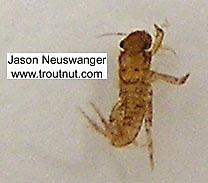 View 3 PicturesThis is a really really really really tiny mayfly nymph. It has gills on abdominal segments 3-7 in the characteristic orientation for the Ephemerellidae family, and it has no fain tail as best I can tell, just uniform tail coverage with small black hairs of equal length. I think this one's too young to identify.
View 3 PicturesThis is a really really really really tiny mayfly nymph. It has gills on abdominal segments 3-7 in the characteristic orientation for the Ephemerellidae family, and it has no fain tail as best I can tell, just uniform tail coverage with small black hairs of equal length. I think this one's too young to identify.
 View 3 PicturesThis is a really really really really tiny mayfly nymph. It has gills on abdominal segments 3-7 in the characteristic orientation for the Ephemerellidae family, and it has no fain tail as best I can tell, just uniform tail coverage with small black hairs of equal length. I think this one's too young to identify.
View 3 PicturesThis is a really really really really tiny mayfly nymph. It has gills on abdominal segments 3-7 in the characteristic orientation for the Ephemerellidae family, and it has no fain tail as best I can tell, just uniform tail coverage with small black hairs of equal length. I think this one's too young to identify.Collected March 10, 2004 from unknown in Wisconsin
Added to Troutnut.com by Troutnut on January 19, 2006
Added to Troutnut.com by Troutnut on January 19, 2006
Eurylophella (Chocolate Duns) Mayfly Nymph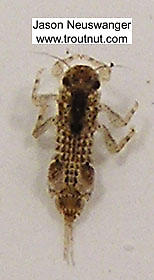 View 2 PicturesIt has the segment 4 gill and abdominal segment 9 is longer than segment 8. I couldn't see abdominal tubercles (
View 2 PicturesIt has the segment 4 gill and abdominal segment 9 is longer than segment 8. I couldn't see abdominal tubercles (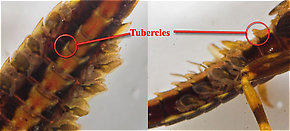 Tubercle: Various peculiar little bumps or projections on an insect. Their character is important for the identification of many kinds of insects, such as the nymphs of Ephemerellidae mayflies.), but they may not yet be developed in such an early instar (Instar: Many invertebrates molt through dozens of progressively larger and better-developed stages as they grow. Each of these stages is known as an instar. Hard-bodied nymphs typically molt through more instars than soft-bodied larvae.).
Tubercle: Various peculiar little bumps or projections on an insect. Their character is important for the identification of many kinds of insects, such as the nymphs of Ephemerellidae mayflies.), but they may not yet be developed in such an early instar (Instar: Many invertebrates molt through dozens of progressively larger and better-developed stages as they grow. Each of these stages is known as an instar. Hard-bodied nymphs typically molt through more instars than soft-bodied larvae.).
 View 2 PicturesIt has the segment 4 gill and abdominal segment 9 is longer than segment 8. I couldn't see abdominal tubercles (
View 2 PicturesIt has the segment 4 gill and abdominal segment 9 is longer than segment 8. I couldn't see abdominal tubercles (
A few (not all) of the abdominal tubercles on this Ephemerella needhami nymph are circled. They are especially large in this species.
Collected March 10, 2004 from unknown in Wisconsin
Added to Troutnut.com by Troutnut on January 19, 2006
Added to Troutnut.com by Troutnut on January 19, 2006
Female Ephemerellidae (Hendricksons, Sulphurs, PMDs, BWOs) Mayfly Dun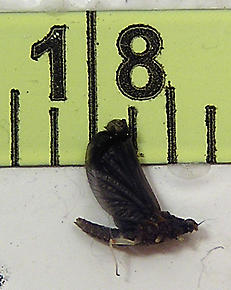 View 2 PicturesI've tentatively called this fragile, highly damaged dun a Serratella species. I had much better pictures of the species but lost them. It's about size 22, but good-sized trout were rising to this hatch; I suspect it has to do with the solid profile shown by the dark, almost-black wings that have given this hatch the name "Darth Vaders" among some Wisconsin anglers.
View 2 PicturesI've tentatively called this fragile, highly damaged dun a Serratella species. I had much better pictures of the species but lost them. It's about size 22, but good-sized trout were rising to this hatch; I suspect it has to do with the solid profile shown by the dark, almost-black wings that have given this hatch the name "Darth Vaders" among some Wisconsin anglers.
 View 2 PicturesI've tentatively called this fragile, highly damaged dun a Serratella species. I had much better pictures of the species but lost them. It's about size 22, but good-sized trout were rising to this hatch; I suspect it has to do with the solid profile shown by the dark, almost-black wings that have given this hatch the name "Darth Vaders" among some Wisconsin anglers.
View 2 PicturesI've tentatively called this fragile, highly damaged dun a Serratella species. I had much better pictures of the species but lost them. It's about size 22, but good-sized trout were rising to this hatch; I suspect it has to do with the solid profile shown by the dark, almost-black wings that have given this hatch the name "Darth Vaders" among some Wisconsin anglers.Collected July 14, 2004 from unknown in Wisconsin
Added to Troutnut.com by Troutnut on January 25, 2006
Added to Troutnut.com by Troutnut on January 25, 2006
Maccaffertium modestum (Cream Cahill) Mayfly Nymph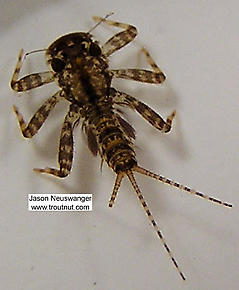 View 2 PicturesI looked at this nymph closely under my crappy microscope. It has truncate (Truncate: Cut off. This is often used to describe the square appearance of the gills of Maccaffertium mayfly nymphs, for example, as opposed to the pointed gills of the closely related genus Stenacron.) as opposed to rounded gills, postero-lateral (Lateral: To the side.) spines only on abdominal segments 7-9, and oblique crossbars through the center of each sterna, not on the posterior (Posterior: Toward the back of an organism's body. The phrase "posterior to" means "in back of.") edge like on some of the other Maccaffertium species. As best I can tell from the keys this is either modestum or ithaca and from the distribution maps I've seen I'm guessing it's modestum.
View 2 PicturesI looked at this nymph closely under my crappy microscope. It has truncate (Truncate: Cut off. This is often used to describe the square appearance of the gills of Maccaffertium mayfly nymphs, for example, as opposed to the pointed gills of the closely related genus Stenacron.) as opposed to rounded gills, postero-lateral (Lateral: To the side.) spines only on abdominal segments 7-9, and oblique crossbars through the center of each sterna, not on the posterior (Posterior: Toward the back of an organism's body. The phrase "posterior to" means "in back of.") edge like on some of the other Maccaffertium species. As best I can tell from the keys this is either modestum or ithaca and from the distribution maps I've seen I'm guessing it's modestum.
 View 2 PicturesI looked at this nymph closely under my crappy microscope. It has truncate (Truncate: Cut off. This is often used to describe the square appearance of the gills of Maccaffertium mayfly nymphs, for example, as opposed to the pointed gills of the closely related genus Stenacron.) as opposed to rounded gills, postero-lateral (Lateral: To the side.) spines only on abdominal segments 7-9, and oblique crossbars through the center of each sterna, not on the posterior (Posterior: Toward the back of an organism's body. The phrase "posterior to" means "in back of.") edge like on some of the other Maccaffertium species. As best I can tell from the keys this is either modestum or ithaca and from the distribution maps I've seen I'm guessing it's modestum.
View 2 PicturesI looked at this nymph closely under my crappy microscope. It has truncate (Truncate: Cut off. This is often used to describe the square appearance of the gills of Maccaffertium mayfly nymphs, for example, as opposed to the pointed gills of the closely related genus Stenacron.) as opposed to rounded gills, postero-lateral (Lateral: To the side.) spines only on abdominal segments 7-9, and oblique crossbars through the center of each sterna, not on the posterior (Posterior: Toward the back of an organism's body. The phrase "posterior to" means "in back of.") edge like on some of the other Maccaffertium species. As best I can tell from the keys this is either modestum or ithaca and from the distribution maps I've seen I'm guessing it's modestum.Collected March 10, 2004 from unknown in Wisconsin
Added to Troutnut.com by Troutnut on January 19, 2006
Added to Troutnut.com by Troutnut on January 19, 2006
Hydropsychidae Caddisfly Larva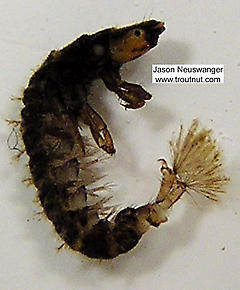 View 3 Pictures
View 3 Pictures
 View 3 Pictures
View 3 PicturesCollected March 9, 2004 from unknown in Wisconsin
Added to Troutnut.com by Troutnut on January 25, 2006
Added to Troutnut.com by Troutnut on January 25, 2006
Start a Discussion of Miscellaneous:
Top 10 Fly Hatches
Top Gift Shop Designs
Eat mayflies.
Top Insect Specimens
Miscellaneous Sites
Troutnut.com is copyright © 2004-2024 Jason
Neuswanger (email Jason). See my FAQ for information about use of my images.
 privacy policy
privacy policy
